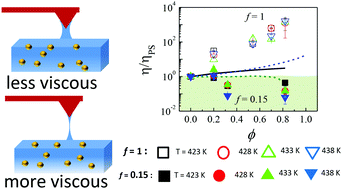Engineering interfacial entropic effects to generate giant viscosity changes in nanoparticle embedded polymer thin films†
Abstract
Thin polymer and polymer nanocomposite (PNC) films are being extensively used as advanced functional coating materials in various technological applications. Since it is widely known that various properties of these thin films, especially their thermo-mechanical behavior, can be considerably different from the bulk depending on the thickness as well as interaction with surrounding media, it is imperative to study these properties directly on the films. However, quite often, it becomes difficult to perform these measurements reliably due to a dearth of techniques, especially to measure mechnical or transport properties like the viscosity of thin polymer or PNC films. Here, we demonstrate a new method to study the viscosity of PNC thin films using atomic force microscopy based force–distance spectroscopy. Using this method we investigated viscosity and the glass transition, Tg, of PNC thin films consisting of polymer grafted nanoparticles (PGNPs) embedded in un-entangled homopolymer melt films. The PGNP–polymer interfacial entropic interaction parameter, f, operationally controlled through the ratio of grafted and matrix molecular weight, was systematically tuned while maintaining good dispersion even at very high PGNP loadings, ϕ. We observed both a significant reduction (low f) and giant enhancement (high f) in the viscosity of the PNC thin films with the effect becoming more prominent with increasing ϕ. Significantly, none of the established theoretical models for viscosity changes observed earlier in suspensions or polymer nanocomposites can explain the observed viscosity variation. Our results thus not only demonstrate the tunability of the interfacial entropic effect to facilitate a dramatic change in the viscosity of PNC coatings, which could be of great utility in various applications of these materials, but also suggest a new regime of viscosity variation in athermal PNC films indicating the possible need for a new theoretical model.



 Please wait while we load your content...
Please wait while we load your content...